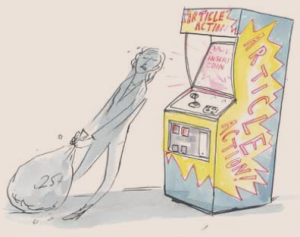 Articling as we know it in Ontario is no longer sustainable. Lawyers rave about articling, but are not willing to finance it. There are not enough positions for those who want and need them, and that’s not going to get better in the foreseeable future. About 500 individuals who obtained their law degree overseas, many of them Canadian, are expected to seek admission to the Law Society of Upper Canada this year — along with all of our locally graduated law students. Soon someone will successfully challenge the articling requirement as an unlawful barrier to entering the profession.
Articling as we know it in Ontario is no longer sustainable. Lawyers rave about articling, but are not willing to finance it. There are not enough positions for those who want and need them, and that’s not going to get better in the foreseeable future. About 500 individuals who obtained their law degree overseas, many of them Canadian, are expected to seek admission to the Law Society of Upper Canada this year — along with all of our locally graduated law students. Soon someone will successfully challenge the articling requirement as an unlawful barrier to entering the profession.
Few of the solutions proposed by the articling task force set up by the Law Society deal with the issue of accessibility. They are all expensive for students. Good luck financing reform by asking LSUC members to pay higher dues! The evidently favoured practical legal training course (PLTC) option would create two tiers of graduates: those paid to article and those who must pay to train in less effective simulated practice situations. Equity issues loom large.
Consider allowing students who cannot obtain articles to instead obtain a restricted licence to practice. This variation on the task force’s third option would have a side benefit: it would also increase the supply of affordable basic legal services in the province.
Imagine, for example, a restricted licence to practice family law. (The LSUC could identify a handful of practice areas to support.) JD graduates would complete the regular licensing process and then engage in deeper self-study and take additional exams in family law. They would also take an online practice/client management course. There would be a creative component on how to practice law without the in-firm art collection; that is, how to offer low overhead, low fee basic service. Mentoring would be facilitated by the LSUC.
The Law Society would engage in proactive monitoring. After two years, the restricted practitioner could apply to have the practice formally reviewed. Upon successful review, the restricted practitioner would obtain full admission.
This too is a two–tiered system, but it would be cost effective and the restricted practice might even generate a modest income. Like articling, the experience would be real, not simulated. The restricted practitioner would know more about the basic practice of street-level law than someone who had articled in the finest program on Bay Street and this could one day transform the restricted practice option into the preferred way to proceed to the bar.
This option provides more preparation for practice than the New York model, where graduates must take expensive private bar preparation courses and write gruelling bar examinations, eventually entering practice without obtaining any practical training whatsoever. Unless we come up with a creative solution soon, the New York model will be the only viable plan left for Ontario. Would it not be better to adopt a restricted practice model that addresses both entry to the profession and access to legal services at the same time? With this solution, everyone gets something and our profession doesn’t take on extra, unnecessary costs.
Bruce Feldthusen is the dean of the Faculty of Law, Common Law Section at the University of Ottawa.
Illustration by Graham Roumieu

